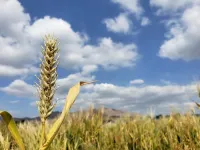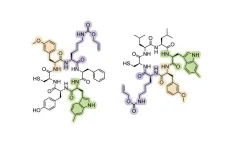(Press-News.org) Thanks to an experiment started before the Great Depression, researchers have pinpointed the genes behind the remarkable adaptability of barley, a key ingredient in beer and whiskey. These insights could ensure the crop’s continued survival amidst rapid climate change.
Grown everywhere from Asia and Egypt to Norway and the Andes mountains of South America, barley is one of the world’s most important cereal crops and has been for at least 12,000 years. As it has spread across the globe, random changes to its DNA allowed it to survive in each new location.
It is critical to identify the genes that changed to predict which varieties will thrive in places now struggling with increasingly hotter temperatures, longer stretches of drought, and more dramatic storms.
“Breeders have long understood the need to develop crops that were well tuned to their local environment. So, a century ago, they started this experiment in Davis, California with barley varieties from all over the world with the goal of identifying locally adapted varieties,” said Dan Koenig, UC Riverside geneticist.
“The scientists who started the experiment didn’t have the ability to pinpoint which genes make barley successful and high yielding in a particular environment, but we can now study tens of millions of genetic changes in a single experiment in my laboratory,” Koenig said.
Dozens of genes that contribute to barley’s adaptability are described in a new study appearing in the journal Science. Koenig, who is corresponding author of the study, explained that some of the genes they identified help barley time its reproductive processes to the most optimal parts of the breeding season.
“Flowering either too early or too late means the plant won’t be able to produce seeds,” said Koenig. “For crops to produce the maximum amount of seed, they must flower in a very narrow window.”
In California, crops must finish flowering before the long dry season begins, or there won’t be enough water to make seeds. But if the plants flower too early, they might be exposed to frost. The researchers identified how genetics enable flowering in exactly the right window, with several genes promoting early flowering and others reducing late flowering.
Identifying these genes was not an easy process. “One of the challenges in understanding genetic adaptations is that seeing it can take decades, since you can only grow one generation of barley a year,” Koenig said.
Fortunately, Koenig and his colleagues has access to the Barley Composite Cross II experiment, founded in Davis, California in 1929 ¾ one of the world’s oldest biological experiments. It was initiated to discover new barley varieties for the California market. Breeders competed thousands of genetically distinct types of barley against one another for decades in Davis. The barley that grew best in the hot, dry California climate outcompeted its neighbors and became more frequent over time.
Koenig’s group realized the seed from this experiment could be used as a time machine to directly observe the process of adaptation and to identify genes that enabled survival.
During these 58 growing seasons, the field went from 15,000 genetically distinct individual plants to a single plant lineage dominating 60% of the population ¾ with no selection at all by human beings.
“We were shocked by the amount of change that occurred over a short evolutionary time,” Koenig said. “Natural selection completely reshaped genetic diversity across the whole genome in just a human’s lifetime.”
The research team is planning additional studies to examine long-term experimental data from different climates, to understand how the timing of flowering may be tuned differently.
Also, the team would like to gain a better understanding of something curious they observed. During the Davis experiment, the population of plants contained varieties from many places. As they adapted to Northern California, the plants naturally increased their yield by almost double. However, this increase is still less than what breeders get with a manual selection strategy.
“Yield may be in competition with other traits, such as growing fast, or tall,” Koenig said. “Growers want plants that make for friendly neighbors, but being friendly might limit adaptation to the environment.”
Because barley is genetically similar to wheat, rice, and corn, insights into how it survives in such diverse environments could be used to help these other grains adapt to climate extremes.
Using modern technology like genome engineering and CRISPR, researchers could try to engineer other crops that flower at specific, more advantageous times.
“Barley’s ability to adapt has served as a cornerstone to the development of civilization. Understanding it is important not just to keep making alcoholic beverages, but also for our ability to develop the crops of the future and enhance their ability to adapt as the world changes,” Koenig said.
END
Century-old experiment secures beer and whiskey’s future
Genetic insights could help grains endure climate change
2024-09-11
ELSE PRESS RELEASES FROM THIS DATE:
Researchers improve search for cancer drivers
2024-09-11
PULLMAN, Wash. -- A computer algorithm can efficiently find genetic mutations that work together to drive cancer as well as other important genetic clues that researchers might someday use to develop new treatments for a variety of cancers.
Reporting in the journal Frontiers in Bioinformatics, a Washington State University-led team used a novel network computer model to find co-occurring mutations as well as other similarities among DNA sequence elements across several types of cancer. The model allows for easier searches for patterns in huge seas of cancer genetic data.
“This is a ...
Mirror, mirror, in my tank, who’s the biggest fish of all?
2024-09-11
What if that proverbial man in the mirror was a fish? Would it change its ways? According to an Osaka Metropolitan University-led research group, yes, it would.
In what the researchers say in Scientific Reports is the first time for a non-human animal to be demonstrated to possess some mental states (e.g., mental body image, standards, intentions, goals), which are elements of private self-awareness, bluestreak cleaner wrasse (Labroides dimidiatus) checked their body size in a mirror before choosing whether to attack fish that were slightly larger or smaller than themselves.
The ...
Scripps Research scientists expand the genetic alphabet to create new proteins
2024-09-11
LA JOLLA, CA—It’s a dogma taught in every introductory biology class: Proteins are composed of combinations of 20 different amino acids, arranged into diverse sequences like words. But researchers trying to engineer biologic molecules with new functions have long felt limited by those 20 basic building blocks and strived to develop ways of putting new building blocks—called non-canonical amino acids—into their proteins.
Now, scientists at Scripps Research have designed a new paradigm for easily adding non-canonical amino acids to proteins. Their approach, described in Nature Biotechnology on September 11, 2024, revolves around using ...
Breakthrough research sheds light on the hidden effects of stress on sperm
2024-09-11
A groundbreaking study led by researchers at the University of Colorado Anschutz Medical Campus reveals that stress-induced changes in sperm motility occur after a stressful event, rather than during it and improves sperm performance. The discovery is essential in understanding how stress impacts the reproductive process to improve fetal development outcomes.
The study was published today in Nature Communications.
Over the last five decades, there has been a notable decline in semen quality, which has coincided with environmental stressors. This new research identifies how stress affects the ability of ...
Throat problems could impair autonomic nervous system's ability to regulate blood pressure
2024-09-11
Throat problems could impair autonomic nervous system's ability to regulate blood pressure
Research suggests problems at junction between air and food passages may ‘overwhelm’ the Vagus nerve
Patients with throat problems were less able to regulate their blood pressure in a new study led by the University of Southampton.
The study published in JAMA Otolaryngology is the first to observe reduced baroreflex sensitivity in patients with throat symptoms.
The baroreflex is a crucial part of the autonomic nervous system which detects changes ...
Pandemic of homicide grief in global Black communities urgently needs a public health response
2024-09-11
The Centre for Research and Innovation for Black Survivors of Homicide Victims (The CRIB) is calling for decisive action to address the grief from homicide that is disproportionately affecting Black communities worldwide — and to tackle the root causes of homicide that impact this population.
In a paper published in the journal Homicide Studies, University of Toronto social work professor Tanya Sharpe and colleagues argue that the prevalence and spread of homicide grief — the grief that follows the ...
How do human and dog interactions affect the brain?
2024-09-11
During social interactions, the activity of the brain’s neurons becomes synchronized between the individuals involved. New research published in Advanced Science reveals that such synchronization occurs between humans and dogs, with mutual gazing causing synchronization in the brain’s frontal region and petting causing synchronization in the parietal region. Both regions are associated with attention.
The strength of this synchronization increased with growing familiarity of human–dog pairs over 5 days, and tests indicated that the human is the leader while ...
Can green finance effectively reduce carbon dioxide emissions while promoting economic growth?
2024-09-11
New research published in Business Strategy and the Environment based on information from G7 countries demonstrates that green finance—loans, investments, and incentives that support environmentally-friendly projects and activities—can reduce carbon dioxide emissions. Also, data indicate that investments in green projects are profitable.
The study found that G7 countries' environmental conditions have been negatively impacted by economic development; however, there are advantages of green finance solutions for economic growth.
The study’s investigators ...
Are there racial differences in the use of opioids after returning home from hospitalizations for hip fractures?
2024-09-11
In an analysis of information on 164,170 older adult Medicare beneficiaries who were hospitalized for hip fractures, a similar proportion of Black and white beneficiaries used opioids after they were discharged and returned to the community, but Black beneficiaries consistently received lower doses of the pain medications.
In the study published in the Journal of the American Geriatrics Society, investigators observed that on average Black beneficiaries received the equivalent of around 250 fewer milligrams ...
Are long stems on flowers an adaptation that encourages bat pollination?
2024-09-11
Flowers that are pollinated by bats tend to have long stems that make them stand out from the surrounding foliage. New research published in New Phytologist reveals the evolutionary advantage that this characteristic provides to plants to ensure that they are discovered by bats.
In simple backgrounds lacking foliage, bats showed no significant difference in the time it took them to find flowers with long versus short stems, but in complex backgrounds (with arrays of leaves and flowers), bats took nearly twice as much time to locate short-stemmed flowers.
Investigators hypothesize that flowers located away from the surrounding foliage likely help bats to distinguish ...
LAST 30 PRESS RELEASES:
Bulk inorganic crystals grown from water emit “handed” light
A new AI-based attack framework advances multi-agent reinforcement learning by amplifying vulnerability and bypassing defenses
While exploring the cosmos, astronauts also fuel explorations of the biology of aging and cellular resilience
Design and synthesis of Zr-IR825 nanoparticles for photothermal therapy of tumor cells
Food critics or food grabbers? When choosing food, wood mice split into careful examiners who sniff and handle, and quick nut grabbers
‘Cosmic clock’ reveals Australian landscapes’ history and potential future
Higher maternal blood pressure increases the risk of pregnancy complications, study concludes
Postoperative complications of medical tourism may cost NHS up to £20,000/patient
Phone apps nearly 3 times as good as no/basic support for quitting smoking long term
Female sex and higher education linked to escalating prevalence of obesity and overweight in Africa
THE LANCET + eCLINICALMEDICINE: Two studies on reductions in mortality from small changes lifestyle changes
AI model identifies how every country can improve its cancer outcomes
Young people risk drifting into serious online offenses through a slippery slope of high-risk digital behavior
Implant provides lasting relief for treatment-resistant depression
Autologous T cell therapy targeting multiple antigens shows promise treating pancreatic cancer
First extensive study into marsupial gut microbiomes reveals new microbial species and antimicrobial resistance
Study debunks myth of native Hawaiians causing bird extinctions
Tailored biochar could transform how crops grow, resist disease, and clean polluted soils
Biochar-based enzyme technology offers new path for cleaner water and soil
Biochar helps farmland soils withstand extreme rain and drought by steadying carbon loss
New study reveals major gaps in global forest maps
Ochsner Health names Dr. Timothy Riddell executive vice president and chief operating officer
Can future-focused thoughts help smokers quit?
From brain scans to alloys: Teaching AI to make sense of complex research data
Stem Cell Reports seeks early career editors to join the editorial board
Signs of ancient life turn up in an unexpected place
Pennington Biomedical researchers explore factors behind body’s ability to regulate weight
Zhongping Lee awarded the Nils Gunnar Jerlov Medal
Deborah S. Kelley awarded the Wallace S. Broecker Medal
Novel immunotherapy demonstrates early potential to overcome resistance to immune checkpoint therapy
[Press-News.org] Century-old experiment secures beer and whiskey’s futureGenetic insights could help grains endure climate change



